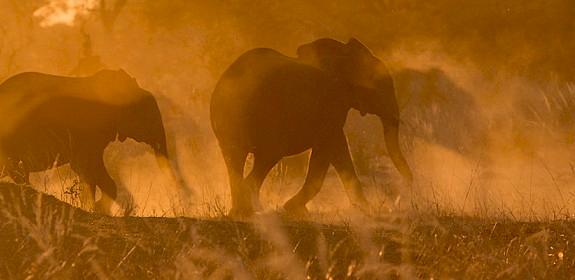Rhinos in crisis – poaching and illegal trade reach highest levels in over 20 years
Gland, Switzerland, 15th January 2013—Escalating levels of poaching and illegal trade in rhino horns are seriously undermining rhino conservation efforts, putting the survival of these species at risk—according to a report by IUCN (International Union for Conservation of Nature) and TRAFFIC.

The report examines the conservation status and trade in African and Asian rhino species.
“The findings of the report are alarming,” says Tom Milliken, a rhino expert from TRAFFIC. “Today, rhino poaching and illegal horn trade are at their highest levels in over 20 years, threatening to reverse years of conservation effort, particularly in Africa. There is no doubt that rhino species are facing a serious crisis.”
According to the report, by the beginning of 2011 there were 20,165 White Rhinoceros Ceratotherium simum and 4,880 Black Rhinoceros Diceros bicornis in Africa. However, at least 1,997 rhinos were poached between 2006 and September 2012 and over 4,000 rhino horns have been illegally exported from Africa since 2009, with an estimated 92% of these coming from rhinos specifically killed to obtain their horn.
South Africa, home to 83% of Africa’s rhinos and 73% of all wild rhinos worldwide, is the principal source of rhino horns in illegal trade. A record 668 rhinos were poached there in 2012, according to official government figures released in January 2013.
Illegal trade in rhino horns involves highly organised, mobile and well-financed criminal groups, mainly composed of Asian nationals based in Africa. These networks have recruited pseudo-hunters including Vietnamese citizens, Thai prostitutes and proxy hunters from the Czech Republic and Poland to obtain rhino horns in South Africa on the pretence of trophy hunts for illegal commercial trade purposes.
Pseudo-hunting has significantly reduced as a result of a decision to prevent nationals of Viet Nam from obtaining hunting licenses and changes to South African law in April 2012. However, there remains a continued need to ensure that only bona fide hunters are granted permits, according to the report.
“Rhinos are killed for their horns, which are seen as highly desirable status symbols in parts of Asia, notably Viet Nam, but also increasingly in China,” says Bibhab Kumar Talukdar, Chair of IUCN Species Survival Commission’s (SSC) Asian Rhino Specialist Group. “Horns are also increasingly used for non-traditional purposes such as hangover cure and body detoxifyer, especially in Viet Nam.”
In Asia, although conservation action in Nepal and India has resulted in increased numbers of the Greater One-horned Rhinoceros Rhinoceros unicornis, the situation in Indonesia and Malaysia remains serious for the world’s two rarest rhino species—the Sumatran Rhinoceros Dicerorhinus sumatrensis and the Javan Rhinoceros Rhinoceros sondaicus. The Javan Rhinoceros, with only around 35 to 45 surviving individuals, is confined to a single park in Indonesia after the last animal of its Indochinese subspecies, Rhinoceros sondaicus annamiticus, was found dead, its horn removed, in Viet Nam in 2010. The report calls for enhanced protection and biological management of the remaining Sumatran and Javan Rhinoceros to prevent their extinction.
Thefts of rhino horns from museums and zoos have increased worldwide, creating the need for improved law enforcement, monitoring and enhanced information management with regards to rhino numbers, sales and translocations, the report finds.
“Trade in rhino horns is a global problem that needs to be addressed by the international community by putting pressure on those countries that are driving illegal trade in rhino horn and those with inadequate wildlife legislation, such as Mozambique,” says Richard Emslie, from IUCN SSC African Rhino Specialist Group. “At the same time, increased poaching is negatively affecting rhino conservation incentives and budgets, threatening future rhino population growth.”
The report was compiled by the IUCN SSC African and Asian Rhino Specialist Groups and TRAFFIC, the wildlife trade monitoring network. It was mandated by the Convention on International Trade in Endangered Species (CITES) and aims to inform the rhino horn debate at the 16th meeting of the Conference of the Parties to CITES, taking place in March 2013 in Bangkok, Thailand.
Notes:
In August 2012, TRAFFIC published a comprehensive report into the rhino horn trade between South Africa and Viet Nam: The South Africa—Viet Nam Rhino Horn Trade Nexus: A deadly combination of institutional lapses, corrupt wildlife industry professionals and Asian crime syndicates.
About TRAFFIC

TRAFFIC is a leading non-governmental organisation working to ensure that trade in wild species is legal and sustainable, for the benefit of the planet and people.
About IUCN

The International Union for Conservation of Nature (IUCN) is a membership Union uniquely composed of both government and civil society organisations. It provides public, private and non-governmental organisations with the knowledge and tools that enable human progress, economic development and nature conservation to take place together. For more information visit: iucn.org
About Species Survival Commission

The IUCN Species Survival Commission (SSC) is a science-based network of more than 7,500 volunteer experts from almost every country of the world, all working together towards achieving the vision of, "A just world that values and conserves nature through positive action to reduce the loss of diversity of life on earth".




